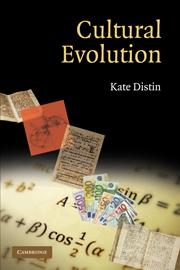Book contents
- Frontmatter
- Contents
- Cultural Evolution
- 1 Introduction
- PART I THE INHERITANCE OF CULTURAL INFORMATION
- 2 What Is Information?
- 3 How Is Information Inherited?
- PART II THE INHERITANCE OF CULTURAL INFORMATION
- PART III THE INHERITANCE OF CULTURAL INFORMATION
- PART IV THE RECEIVERS OF CULTURAL INFORMATION
- PART V THE EXPRESSION OF CULTURAL INFORMATION
- 14 Conclusion
- Appendix
- Acknowledgements
- Bibliography
- Index
3 - How Is Information Inherited?
Published online by Cambridge University Press: 05 June 2012
- Frontmatter
- Contents
- Cultural Evolution
- 1 Introduction
- PART I THE INHERITANCE OF CULTURAL INFORMATION
- 2 What Is Information?
- 3 How Is Information Inherited?
- PART II THE INHERITANCE OF CULTURAL INFORMATION
- PART III THE INHERITANCE OF CULTURAL INFORMATION
- PART IV THE RECEIVERS OF CULTURAL INFORMATION
- PART V THE EXPRESSION OF CULTURAL INFORMATION
- 14 Conclusion
- Appendix
- Acknowledgements
- Bibliography
- Index
Summary
Evolution in any sphere results from the persistent heredity of variations. What has emerged from the previous chapter is that each generation can detect and react to inherited variations only if it can discretely represent them – and any variation that a receiver discretely represents is information. It turns out that information is indeed “a difference which makes a difference” (Bateson 1972: 453).
The inheritance of information is therefore dependent on the representational capacities of each generation of receivers. We have seen that it is the receiver's discrete representational knowledge, whether in the form of a single representation or of an overarching representational system, which enables it to react appropriately to a source of information. This means that the interpretation and effects of information will depend not only on the content of the information itself but also on variation among its receivers. If a receiver cannot form discrete representations of variations in the information that it receives, then it will be able neither to react to those variations nor to transmit them to another receiver.
If heredity depends on successive generations of receivers with the appropriate representational knowledge, then the mechanisms of heredity need to ensure that each generation receives not only information but also its means of interpretation and implementation. Jablonka and Lamb (2005) have proposed a four-dimensional account of biological evolution, in which not only genetic but also epigenetic, behavioural and symbolic inheritance mechanisms play their part.
- Type
- Chapter
- Information
- Cultural Evolution , pp. 25 - 46Publisher: Cambridge University PressPrint publication year: 2010



